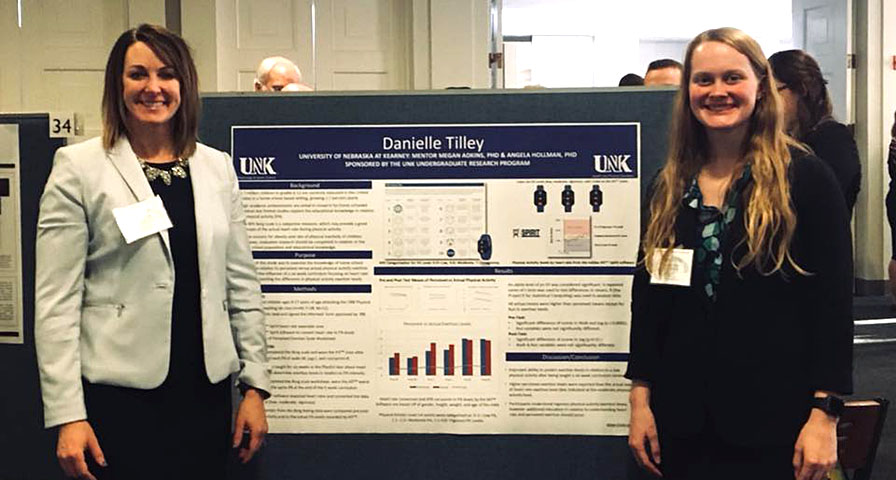‘Posters on the Hill’ winner teaches students how to accurately assess their effort, improve exercise intensity levels with PE heart rate technology
A student research project recognized by the Council for Undergraduate Research demonstrated how physical education heart rate technology gave homeschool students a more accurate picture of their fitness levels by showing the differences between their perceived and actual exertion levels.
Danielle Tilley, a third-year education student at the University of Nebraska-Kearney, earned a trip to Washington, D.C. when her research project was selected as one of 60 winners in the Council for Undergraduate Research’s 2018 “Posters on the Hill” contest. More than 400 students submitted their projects. Of the winners, only three posters focused on education, and only Tilley studied physical education.
While the aspiring PE teacher enjoyed the individual honor, she was equally proud of the recognition for her field of study.
“PE is often overlooked so I’m glad that I could show that because of the research we do in the field, there’s a lot more to physical education than just exercise,” Tilley said.
Utilizing PE Heart Rate Technology to Test Homeschoolers’ Fitness Levels
Tilley presented her results, detailed on a poster, as part of the ceremony in the Rayburn House Office Building on April 18. Her research demonstrated the difference Kearney area homeschool students see in their actual effort level as compared to their perceived effort levels during a weekly physical education class held at UN-K.
“There is a lot of information about the homeschool population when it comes to academics but a very minimal amount of information when it comes to fitness awareness and fitness levels,” said Megan Adkins, Tilley’s advisor for her research project and the chair of the university’s health and physical education program.
While in Washington, Tilley and Adkins met with Nebraska Congressman Adrian Smith, who joined them to speak in detail about her project and homeschoolers in Kearney.
“We really felt listened to because he was asking us questions about Nebraska and the homeschool population that we work with,” Tilley said. “He seemed really interested. It was a great experience because not a lot of people can say that they got to sit down with a representative for 10 or 15 minutes and chat.”
For her research, Tilley developed a six-week curriculum for the homeschool students. The curriculum included:
- A walk, jog, sprint test for students to determine their exercise intensity using the Borg Scale of Perceived Exertion;
- IHT Zone wrist heart rate monitors to determine student heart rate during exercise;
- the IHT Spirit System Assessment Measures software to analyze the student heart rate and show actual exercise intensity during the workout; and
- Research-based lessons designed to introduce students to health-enhancing activities.
Tilley said the students’ initial perceptions were predictable, especially during the walk and sprint portions of the fitness testing. During the jogging portion, students perceived that their exercise intensity was greater than the heart rate data showed.
“When you’re not tired, it’s really easy to tell that, and when you’re out of breath, it’s really easy to tell that,” she said before noting the differences in perceived exertion and actual exertion during the jogging test. “But when you’re in between those, it’s hard to tell exactly where you are. They thought they were in better shape than they are.”
After the six weeks, students left with a better understanding of their actual exertion levels as well as the realization that fitness requires more than attending a PE class once a week.
“If they aren’t exercising outside of that, then they aren’t really exercising at all,” Tilley said. “That might affect their perception. They might not know much about their body or heart rate.”
Understanding PE Technology for Future Teachers
Adkins introduces her students to heart rate technology early in her curriculum and makes sure they are comfortable using the technology both in sessions with homeschoolers but also with themselves in learning situations. The professor earned her doctorate in instructional technology, studied all of the heart rate technology on the market in detail before deciding to include IHT’s suite as a staple of her teaching program.
“I’ve been around the block to know what types of technologies are out there, and this hands-down was the one I was going to go with,” Adkins said. “The capabilities of IHT are not just in the IHT Zone itself. It’s what it can evaluate. I saw it as an evaluative piece at the collegiate level not only for practical experiences to teach students but also on the teacher side.”
In Adkins’ program, the Zone monitors help teach students about their heart rate during exercise, but they also help the future teachers evaluate the standards-based lessons they create.
“I see the IHT monitors as a way to assess not only the students but also the teachers and how effective they can have their classroom while maintaining the quality of the five standards that SHAPE America outlines,” Adkins said.
Tilley, who’s on track to graduate next year after she completes her student-teaching requirement, wants to make her mark as a physical education teacher. She’s seen how the data helped her homeschool students improve their understanding, and she’s seen the Zones motivate students in public school classrooms.
“The minute the Zones start flashing, students are running around the gym trying to see who can get into the red zone the fastest,” Tilley said. “They are really good tools, not only for assessment but also for motivation.”
Helping motivate students is one of the key factors driving Tilley toward a career in physical education. She enjoyed PE as a student and wants to help future students find that same level of enjoyment.
“That’s my biggest thing as a teacher/educator,” she said. “I want to make an impact. I want everyone to find a lifetime activity that they’ll stick with so they can remain physically active for the rest of their lives, that they have fun while doing it.”


